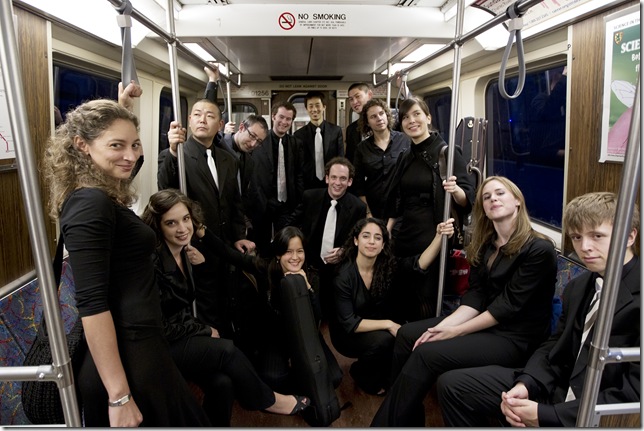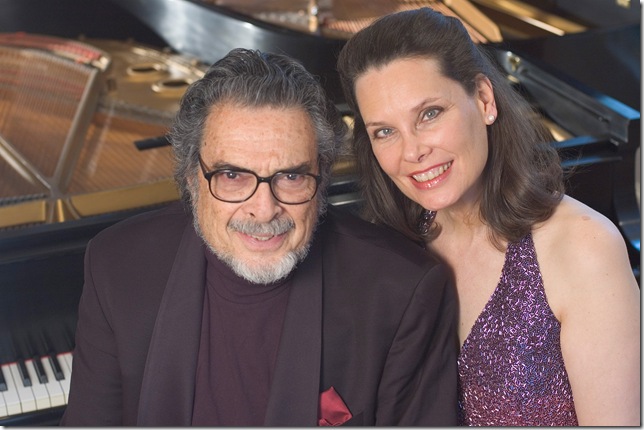The main draw at the Kravis Center’s Regional Arts series on March 25 was, at first glance, pianist Leon Fleisher. Would he play with both hands, or just the left?
At 36, almost 50 years ago, struck with focal dystonia in his right hand, his career might have ended. But trouper that he is, he focused on concertos written for the left hand and remained in the top tier of professional pianists. About 10 years ago, new treatments became available that allowed him to use his right hand once again. At the Kravis, Fleisher, now 85, and his young wife Katherine Jacobson were the piano soloists in a charming, sweet Mozart oddity.
But the big story of the night was the group they played with, A Far Cry Chamber Orchestra. Twenty-two young players who, except for the cellists, stood to play in a program lasting more than two hours. Founded in 2007, the Criers, as they are known, a tightly knit collective of Boston-based musicians, developed an innovative structure of rotating leadership on stage and behind the scenes.
Clad in suits and stylish ties for the men, and colorful long dresses or pants and pretty tops for the women, they reflect the blue-collar Jamaica Plain district of Boston, where they have a shopfront headquarters. No tie and tails, or black dresses, and certainly no conductor, for them. What a wonderful departure from the stodgy sameness we’ve become so used to; these youngsters are on the cutting edge of an orchestral breakthrough that will have concertgoers tumbling over each other to get hear them in the next few years, for their attire, their organization, and their marvelous playing.
The concert opened with Josef Suk’s Serenade for Strings (in E-flat, Op. 6). I first heard this delightful work in 1954 on a Supraphon record by the Czech Philharmonic that I bought in occupied East Berlin (there was no Wall back then). Suk was 18 when he composed it in 1892. And he was in love with Dvořák’s daughter, Otilka, whom he later married.
Whereas Dvořák relied heavily on Czech folk music, Suk drew from it but utilized fewer Czech idioms in an effort to stop the comparisons with his father-in-law. Suk’s Serenade opens with refreshingly spontaneous triplets in the inner parts over sweet lilting phrases and a lovely solo violin. Marked Andante con moto, it is a delight to the ear.
The Allegro ma non troppo e grazioso is full of dance rhythms, livelier than the first movement, and the beautiful Adagio is hauntingly tranquil music, romantic and tender, what one would expect from a young man in love. The finale begins with cheeky scales passed around each section. They meld to form a lower melody in the cellos and double basses with a high accompaniment from the upper strings. Tumbling themes of great sonority lead to a repeat of the first cheeky statement and Suk’s finish is glorious, as was the playing of these fine young artists, every bit as good as Italy’s Solisti Veniti — and that ensemble has a conductor.
Next, followed Mozart’s Concerto for Two Pianos (in F, K. 242). Written in 1776, it was originally tailored for three specific pianists: The Countess Lodron, a Mozart patron, and her two daughters, Aloysia, 15, and Giuseppa, 11, whose part was fairly minimal. In 1780, Mozart rescored it for two pianos and played it in public with his older sister Nannerl in Salzburg just before leaving for Vienna.
The work is light, but the mature output of a brilliant 20-year-old. I was fortunate to be seated where I could see Fleisher’s hands on the keyboard. The first movement opens with a delicate Allegro with the two soloists providing a rich counterpoint. Midway through there is a delightful cadenza where both pianists combine to sound as one brilliant soloist, as Mozart intended. A nice balance between orchestra and pianists was also evident.
In the second movement, a forceful orchestral opening is followed by an even heavier piano duet starting with Fleisher, whose touch and fingering were as delicate as can be; even his right-handed trills were quite remarkable considering it was these two fingers that were afflicted. Fleisher took the lion’s share of the Rondo, with Jacobson taking the lead from her husband with alacrity and charm.
Three of Dvořák’s Slavonic Dances led off the second half, Nos. 1 and 2 from the Op. 46 set, and No. 8 from the Op. 72 collection. This time, two oboes joined the Far Cry as well as two French horns.
No. 1, was a furiant, a fast and fiery Bohemian dance with strong frequently shifting accents. Another very familiar tune led off dance No. 2, a starodavny (ancient dance). It’s a thoughtful, melancholy piece with trilling violins and lots of shading from double forte to double pianissimo, which this orchestra accomplished with agility. The Op. 72 work, No. 8, was also very familiar. The four violas get the tune, a real beauty, full of aching romantic yearning. The accents become more persistent, a nice dramatic buildup and a solo violin lead to an eight-note ending that won warm applause and many bravos.
More Mozart ended the program, his Symphony No. 29 (in A, K. 201), written when he was 18. The orchestral division on stage was very interesting this time. The two French horns and two oboes stood at the rear. The three cellos were just behind the five first violins with the two double basses behind them, stage right. On stage left were the four violas to the rear and the four second violins up front. A new leader gave the downbeat very clearly and this clever instrument placement resulted in a balanced sound for the opening Allegro’s brisk lively tempo.
Great horn playing opened the second movement, with music Mozart divides among the sections with a question half begun, then answered by the next section. It was refreshing to watch the players, each an individual, swaying ever so slightly to the music as their bodies seem to ooze out each note and phrase. The minuet was slow and graceful, a short movement but nonetheless played with sensitivity and care.
The finale, Allegro con spirito, has the full orchestra opening with a romping good tune as the horns blast out above them all with hunting horn calls. The strings ride up the scales then hop about in double time. Small oboe interjections are quite prominent. The exposition goes around all the tunes we’ve heard so far leading to a very mature symphonic ending. During all of this, the players of A Far Cry were still vital, still engaged — and still standing.
This was most rewarding experience for a very appreciative audience. I trust Regional Arts will have them back soon.

